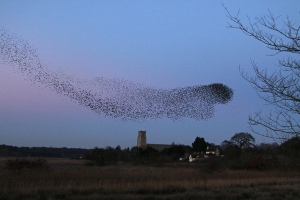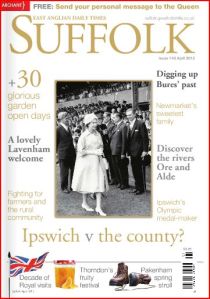An alien with a large white head and purple jumpsuit flaps around a pole at the centre of a Suffolk field. High above, two plastic kestrels are pinned to the sky on wires. In the opposite field, futuristic silver blades flash and glisten in the sun as they spin in the wind. They are mounted on a kind of translucent plastic ball like a prop from an abandoned low budget science fiction film. Welcome then to the world of the 21st century scarecrow.
While improvements in scarecrow technology might mean higher yields for hard-pressed farmers, it is rather a shame for those of us who have enjoyed the sight of the more traditional looking hay-man. The classic image of the vagabond in tails, top hat with the missing lid, turnip head and body stuffed with straw is now more myth than reality. Nowadays, you are hard pressed even to find something in human form.

Cycling through Essex into Suffolk I did a mini audit, where gadgets, for want of a better word, out-numbered scarecrows at least four to one. What scarecrows there were, were sorry looking creations; little more than a knotted bin bag with the suggestion of a head tied to a post. No flippy-floppy hat, no dungarees, no ghostly Christ-like figure just as likely to scare the local school children as much as the birds.
Scarecrows (or Tattie Bogles, Guys or Murmets depending on where you live) are part of the iconography of our countryside. They form part of the cultural as well as the agricultural landscape of rural Britain and are as much art installation as bird deterrent. Their value in preserving crops and seed has always been somewhat spurious – and in fact there is an argument that says that birds are more useful in fields (devouring insects and other pests) than out of then. They are a link to a more ancient time – when superstition gripped the land and determined a farmer’s fortune even more so that the wind and the rain or birds of the sky. They are mannequin, voodoo doll and false god, bundled up in a slightly tatty Paisley shirt.
For most, scarecrows are object of fascination rather than affection. To me anyway, Jon Pertwee’s comic grotesque, Worzel Gummidge, was always more hide-behind-the-sofa TV than Dr Who. They are not to be approached, especially from behind for fear of springing into life; hovering on the edge of the animate, they are totally effective in enforcing the unwritten rule never to cross a farmer’s field.
While scarecrows may be disappearing from our countryside, they live on in poetry and song. Syd Barratt, the boy genius of British pop knew the slightly sinister nursery rhyme world the scarecrow inhabits, with his song from Piper at the Gates of Dawn: ‘His head did no thinking/His head didn’t move except when the wind cut up.’ Walter de la Mare brilliantly evokes the doomed man: ‘All winter though I bow my head/beneath driving rain.’ His scarecrow is reawakened by the turning of the season: ‘But when that child called Spring, and all/his host of children come/ . . ./ some rapture in my rags awakes.’
Read my own poem, The Extraordinary Meditation of the Scarecrow, which suggests where scarecrows travel at night, in my first book The Invention of Butterfly.





